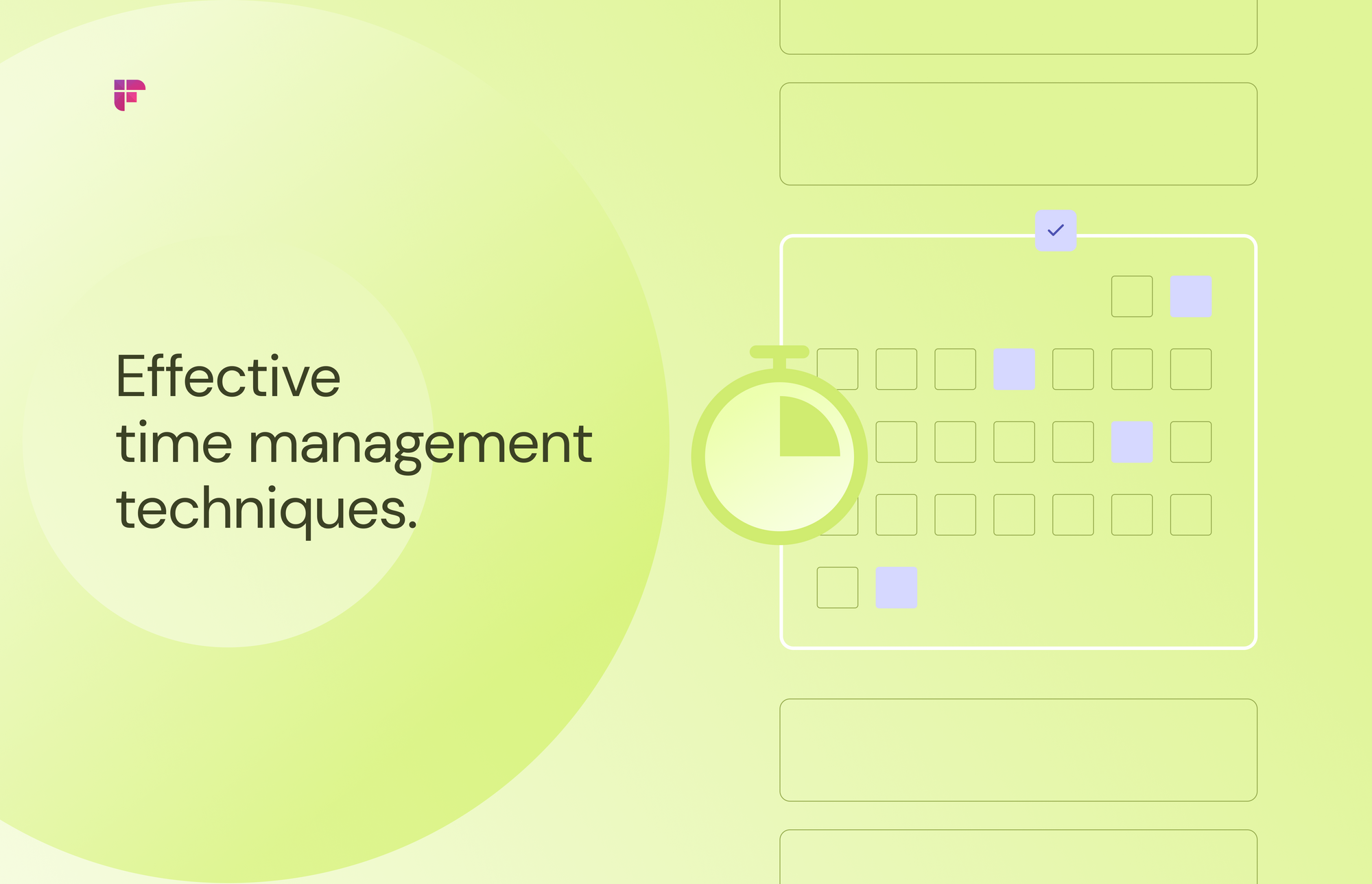Time management is more of an art and less of a hack. Techniques on managing time work on the compounding principle, thus, bringing massive results over time. To get better at managing time, one must be consistent.
Time management techniques help reduce distractions and pinpoint your focus. There are many methods to manage time, but this blog includes sustainable tips that have the most significant impact.
Before getting a grip on your time, let’s understand what time management is.
What is Time Management?

“The bad news is time flies. The good news is you’re the pilot.” -- Michael Altshuler
Time management is planning and allocating time to different activities to improve productivity. It’s also about being self-aware of your priorities and distractions.

The foundation of time management is accepting the fact that time is a limited entity. So you have to smartly distribute it between different tasks to avoid stress and boost efficiency.
The truth is; you can’t manage time because it’s out of your control. Time management is about managing yourself and aligning your goals as per the hours.
Time management is not about being busy or having too much on your plate—that’s actually the opposite. Squeezing many tasks into a single time frame is counterproductive and ineffective.
Managing time means managing your attention. When you plan your schedule, it becomes easy to magnify your attention on the task. Ultimately, it helps you in accomplishing more tasks in less time and with high quality.
Impact of Better Time Management

Let’s consider a scenario:
Jason is a product marketer who works for 10 hours a day because of his unorganized schedule. While working, he opens news and social media tabs to browse. He does it for 10-15 minutes while working on his project. For him, this is a seemingly tiny activity to kill boredom and brings no harm.
But, can 10 mins of scrolling web pages affect productivity?
Yes, it can. Not only productivity, but it also depletes attention. When Jason is working without time management, his mind is stuck between preoccupation and forward projection.
Tim Ferriss, in his book The 4-Hour Work Week, explains:
Preoccupation is obsessing over the event to come. Forward projection is obsessing over the outcome of the current task.
These two occur if you don’t know how to manage time. It fractures your attention that you put into the current task/work. What you’re left with is time without attention, and that holds no value.
That’s why learning how to manage time better is so vital. It increases your attention which leads to:
Increased Work Satisfaction
Working with a distracted mind leads to frustration and low output. When you are performing haphazardly because time is running out, your performance will suffer. Time management helps you get into the workflow and derive the maximum rewards from your job.
Greater Productivity
Productivity is doing things that bring the most results. If you can manage time, you can allocate your mental resources to complete the tasks efficiently. Time management helps in extracting the maximum value from the hours. As a result, you achieve more in less time.
Better Professional Reputation
Companies prefer employees that utilize the company's time and resources efficiently. Time management at the workplace helps in getting things done before the deadline.
Whether it means delivering the project on time or meeting with a client, planning your time avoids delays in progress. All this leads to a better reputation, appreciation, recognition, and good appraisals at the workplace.
Less stress
Scheduling and blocking time slots leads to mental peace and clarity. Time management helps in building a roadmap of responsibilities for the day. When your daily or monthly tasks are sorted out, stress will fade. You’ll also gain confidence that the day is under your control.
Greater Opportunities to Achieve Important Life and Career Goals
Time management is not restricted to the professional world. It’s a wholesome skill that eventually enriches your entire life. Even for a personal goal, breaking it down into smaller chunks and assigning them a time makes them easier to achieve. Say you want to inculcate meditation in your busy schedule. Then with time management, you’d be able to fit it into your day by either delegating unimportant tasks or reducing time spent on redundant tasks.
How to Set Realistic Time Management Goals

To beginners, time management seems like a complex skill that requires extraordinary willpower. In reality, it’s just about understanding how your mind works and planning your day smartly. Managing your time better is a habit you must cultivate. Setting realistic goals is the key here: you need to implement time management gradually.
To become better at setting time management goals, you should understand two things:
Value Put in Time: The flow of time depends upon the power we have over it. If your schedule is messed up, time runs away from you. But if you’ve well managed every hour, time becomes your companion. This is evident because each one of us has the same number of hours, yet only a few become successful at what they do. It boils down to how much value you put into the hours.
Cognitive Bandwidth: Cognitive bandwidth (CB) is our limited resource to make decisions, stick to plan, and resist temptations. It’s the total amount of thinking power you’ve per day. Imagine it to be an energy bar that falls gradually over the day. Time management is all about saving the unnecessary expenditure of CB and putting it into tasks that matter the most. A depleting CB is a reason why you feel burned out.
It’s crucial to understand the value of time and CB before deciding to implement time management techniques. These concepts guide you in setting achievable goals. Tools and tips on managing time can seem overwhelming if you aim to gulp all in one go. In contrast, a practical approach is to create small yet significant goals to master time management bit by bit. Here’s how:
- Identify your Weak Areas: This is the first step of setting goals to figure out why and where you struggle. Time management techniques are exhaustive as they cover all the major issues faced by people. With so many tips available, you need to zero in on those that solve your pain points and ignore the rest. For instance, if you struggle to manage time in your personal life, try techniques that help in managing daily chores.
- Diagnose your Personality: It’s crucial to assess what personality trait is causing a problem. Are you someone who is a master procrastinator? Or you quickly pick a new task but struggle to finish it? Before reading the prescription, diagnose yourself. You can try a personality test to understand your characteristics (16 personalities is an excellent tool for that).
- Make Goals Specific: You can’t hit two targets with one dart. Narrow your focus to one leveraging goal and make it specific. For instance, “I want to become better at time management.” is vague and immeasurable. A better goal is “I want to dedicate six hours for a focused output at work.”
- Put a Timeline: Deciding and working on a new goal for the first two days is easy; it’s backed with motivation. But when the initial motivation drains, you may lose track of progress. Thus, define a timeline and deadline for achieving a goal. It doesn’t have to be perfect, but it should act as a guide. For instance, “I will restrict my work hours to six hours by the end of this month.”
Now, let’s move to the time management principles and techniques to get a grip over your hours.
11 Scientific Time Management Techniques to Seize the Day
Time management is all about strategies to deal with your daily hours. Here are actionable time management techniques that will help you done more in less time:
1. Pareto’s Principle
Pareto’s insights from his pea garden were a great contribution to economics as well as life. As per Pareto, roughly 80% (trivial many) of the outcomes are produced from 20% (vital few) of the input. This is called Pareto’s principle or the 80/20 principle. Not just economics, this principle helps in managing time better too.
To begin with, you need to figure out the vital tasks (20%) that bring you the most results (80%). There are always some tasks and activities that affect the bottom line non-linearly. For instance, if you’re a sales rep, identify the most loyal customers and high-paying customers and invest resources to retain them.
Spend your time on the essential activities to gain more time at the end of the day without affecting performance.
2. Parkinson’s Law
We all have been in a situation where we’ve completed a week-long project two days before the deadline. How do we magically get the focus to finish our project in such a short duration?
The answer is Parkinson’s Law, which states that work adjusts itself to fill the hours allocated to it. Simply, giving a task four hours will take it four hours to complete. Restrict it two, and you can complete it before the clock ticks.
However, be realistic when setting your deadlines. Try completing tasks in an hour less than before and match the output. If the result is the same, continue bringing intensity to your work with shorter deadlines until you hit a sweet spot.
3. Pomodoro System
Working continuously for long hours is detrimental to focus. It results in mental fatigue and burn-out, which decreases the value you put into your time. It is counterintuitive, but frequent short breaks between work make you better at managing time.
When you work intensely and allow your mind to rest, productivity hits the sky. And it saves time spent on making corrections and checking mistakes because of fewer errors.
The Pomodoro system shows us how to create a time management system by defining work and focus periods. As per the method, set focused work duration to 25 minutes, then take a 5 minutes break. Do this for 4 cycles and then take an extended 15-minute break. You can use an actual timer or a Pomo timer app.
4. Eat the Frog
Mornings have the most impact on our entire day, whether on productivity, focus, or time management. If you let your morning hours slip by, the whole day will be gone in a blink. Brian Tracy’s concept of eating the frog first thing in the morning is a sure-shot method to get a grip on the early hours.
As per this technique, the frog is your single most crucial task of the day that majorly affects your daily goals. You must tackle this task at the earliest. If you’ve many frogs, eat the biggest and hardest one first. This method parallels Pareto’s principle as the frog resembles the vital few (20%).
Eating the frog helps you to avoid procrastination and build execution skills. Executing the most critical task without delay affects the bottom line and motivates you to keep moving forward.
5. Eisenhower Matrix
Everything seems important when you don’t have time. This signals that you need to work on prioritization. The Eisenhower Matrix is a simple system that gives you an overview of critical tasks. The matrix contains four categories of tasks:
- Urgent + Important: Time-sensitive tasks that contribute to your current goal (long-term or short-term). Example: finishing a client's project or picking your sick son from school. Do these tasks first and spend a majority of time in this quadrant.
- Not Urgent + Important: Tasks that don’t have an upcoming strict deadline but essential to your goals. Example: exercise, personal development, book reading. Schedule these tasks and develop a routine to follow daily.
- Urgent + Not Important: Tasks that demand immediate attention but don't affect your goals significantly, e.g., low priority emails, phone calls.
- Not Important + Not Urgent: These are distractions that drain your mental energy and suck time. Fine if done in moderation. Example: social media, watching TV, eating junk food.
6. Time Tracking
You can’t save time if you don’t know where it’s being wasted. Constantly feeding your mind with information such as pending hours and work duration leaves you with diminished cognitive bandwidth. That’s why auditing your time is key to gaining back the lost hours.
Record your time in a journal or an app against the activity performed. For beginners, mention the hours invested into each quadrant of the Eisenhower matrix. Do this for seven days, and the results may well shock you. You’ll discover where your time is falling through the cracks.
7. Do Deep Work
Cal Newport coined the term “Deep Work,” which means “the ability to focus without distraction on a cognitively demanding task.
Deep work enables you to explore the untraded cognitive side to bring out the gold. It helps you discover new ideas and achieve optimum output in much, much less time. Additionally, deep work will leave you with a sense of fulfillment at the end of the day.
Performing deep work is analogous to going into the flow state. It can be achieved by:
- Blocking specific hours daily, weekly, and monthly as per your needs.
- Then allocating the crucial tasks into those hours.
- Gathering all the required material and resources needed for the job.
- Cutting off all distractions. Put the phone on silent, block unnecessary tabs, mute notifications, and find an isolated space.
Time management is gaining a few extra hours and increasing the value put into those hours. And this is where deep work becomes necessary.
8. Time Chunking
Let’s do an activity:
Try remembering the number 088177889997.
Done? It must be hard.
Now, remember 088-177-889-997.
Easy? Because that’s chunking --grouping similar things with a pattern.
When our mind switches between two different tasks, a part of the previous task is carried onto the next task. Unconsciously, the mind gives a specific space to the past activity because it was left undone. This depletes our attention, and our mind fails to focus on the task at hand entirely.
Time chunking is a very effective method because it preserves attention. As per the method, you need to devote certain periods (chunks) to specific activities. Instead of allocating hours to an activity, group similar activities and assign them a chunk.
For instance: if you’re someone who lurks in the inbox, try email chunking to achieve inbox zero.
- Set aside a daily time where you’ll check your inbox only. Say, 10:00-10:30 AM every day.
- Spend the time doing the task you decided on without interruptions.
- When you’re done, refrain from doing the same activity at different times unless it’s an emergency.
Time chunking gives you mental peace. You don’t have to think about the events or your responses to the events. Your entire day will become better as you save mental energy to start different tasks.
9. Automate Repetitive Tasks
If you track time and review the details, you will realize how much time you have spent doing repetitive things. Scheduling a meeting, sending follow-ups, taking notes during a meeting, or recalling action items are all mundane tasks.
Activities that require little human interference are better if automated. Many tools and software work on autopilot as per your configuration. This technique needs you to build better systems to improve focus and time management.
Start automating the part of your job/responsibilities that will save you some hours. Figure out if it’s worth delegating to an AI tool. For instance, on average, a professional attends 8 meetings per week; most of them are 30 minutes long.
But a major percentage of meetings are unproductive because the attendees have to multitask (say, taking meeting minutes).
That’s a lot of resources wasted.

Related: How to lead meetings effectively
A better approach is to use automation tools to take meeting notes. Fireflies.ai automatically records and transcribes your entire meetings and sends a rich summary just after the session ends. You can then save time with a smart filter search that identifies the critical information you need.
What’s more, you can review an hour-long meeting within minutes. Sales rep, manager, CEO, student, be it, anyone, automated note-taking with Fireflies.ai saves your time spent in mundane tasks so you can better engage in online conversations.
10. Use Kanban Boards

Kanban boards are an effective tool to track your progress visually. Using Kanban boards makes it easier to locate your task in the timeline. One glance at the board, and you can immediately get an idea of where you should focus.
There are two ways to use Kanban boards: use a whiteboard or an app that uses Kanban boards. If you’ve very few tasks to complete, you can use a whiteboard. If you want a more systematic record of all your progress, an app is the best way (e.g., Trello).
Generally, the columns in a Kanban board are:
- To do
- In-progress
- Completed
If you’re using a whiteboard for Kanban boards, you can either use sticky notes to mention tasks against the column. Or, use Trello to simply add, drag, and drop the task from one column to another. Kanban boards help track the minor elements of a task and give a sense of fulfilment upon completing a project.
11. To-do list

Creating a to-do list might seem insignificant, but it helps in managing time very well. That’s because our mind is constantly preoccupied with past activities, distractions, and pending work. It gets easy to get lost in the messy tangles of several tasks.
It’s best to include urgent and essential functions of the day in the list. Also, include the critical elements necessary to move the project forward (sending email to the director, notifying the cross-functional team on the update, etc.)
Having a to-do list helps you become intentional about your efforts. It improves your overall focus and provides you with vital tasks that should be on your radar.
With a to-do list, you can prioritize the vital tasks, and all that falls outside of it is secondary. Whenever you get distracted, glance at your to-do list to navigate your work progress.
Time Management is Dynamic
Time management is more about managing yourselves than about managing time. The truth is you can’t achieve time management because it’s a continuous process that evolves.
Treat it like a habit that you can develop, cultivate, and improve over time. Eventually, time management will become a keystone habit in your life. The benefits that started with time will swell to other aspects of your life.
Suggested readings:
- Eat the Frog by Brian Tracy
- The 4-Hour Work Week by Tim Ferriss
- Deep Work by Cal Newport








